
Click 'Play' below to See Edited Highlights of the speeches made at the official opening of the newly upgraded angling facilites on 4th april 2008
Features of Lough Aderra
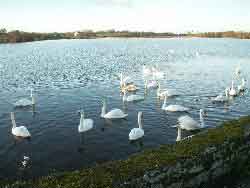 The lake is approximately 30 acres in area and the average depth is between 4 and 5 feet. There are a number of shallow passages, paved by limestone, running across the lake. These were used in the last century by people travelling by horse and car.
The lake is approximately 30 acres in area and the average depth is between 4 and 5 feet. There are a number of shallow passages, paved by limestone, running across the lake. These were used in the last century by people travelling by horse and car.
There is no over-ground inlet to Loughaderra. It is fed by underground springs and it is suggested that the river which flows out of the rock at Dower, Ladysbridge is connected by underground passages to Loughaderra.
The lake had been prone to flooding onto the Cork-Youghal road but this problem was alleviated in the 1960's when the drain connecting it to Ballybutler Lake was improved.
The weather in 1939 was extremely harsh and the lake was used as a skating rink and remained frozen for several weeks. People from far and near came to walk and skate across it. A ford prefect car was driven across it, as was a Honda motorcycle and several boys cycled across. The lake has frozen many times since but not to the extent of 1939.
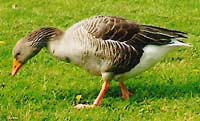
This visitor was spotted at the lake in April 2007. Can anyone identify what it is?
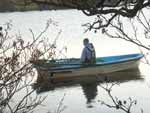 The lake is 16 miles east from Cork City, adjoining the Cork to Waterford (N25) road. Adult Rainbow Trout are stocked regularly to maintain a high stock density and give worthwhile angling returns. The lake also holds a large stock of small Rudd and eels - Rudd forming an important part of the Trout's diet. There are some attractive shore angling sites and six boats are available for hire, but should be booked well in advance due to demand.
The lake is 16 miles east from Cork City, adjoining the Cork to Waterford (N25) road. Adult Rainbow Trout are stocked regularly to maintain a high stock density and give worthwhile angling returns. The lake also holds a large stock of small Rudd and eels - Rudd forming an important part of the Trout's diet. There are some attractive shore angling sites and six boats are available for hire, but should be booked well in advance due to demand.
Rainbow Trout
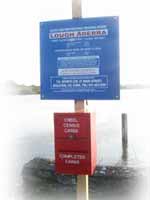 Attains 50cm in third year. Introduced to Europe from North America at the end of the nineteenth century. Easily recognised by a broad iridescent band on each side of the body.
Attains 50cm in third year. Introduced to Europe from North America at the end of the nineteenth century. Easily recognised by a broad iridescent band on each side of the body.
Traditionally the species have been farmed in fresh water ponds but in recent years they have been farmed in sea water. Sea-reared rainbow trout have the same characteristic pink colour as salmon and attain a much larger size than their fresh water counterparts.
Artificial wet flies are the most popular angling method but worms and spinning - in the early summer, have also given excellent returns.
By Barry O'Halloran
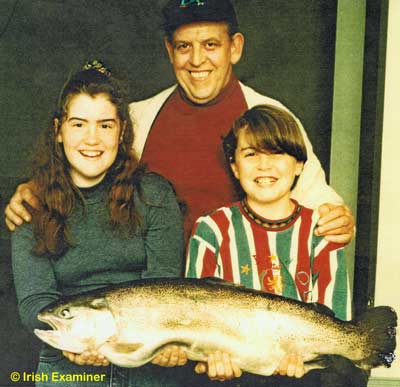
Fr. Terry Gunn, with grand-niece, Carolyn Collins and grand-nephew Robert Collins and his prize catch.
Photo and story courtesy Irish Examiner
A Cork priest struck gold at the end of the rainbow when he took a trip to Lough Aderra yesterday.
After a fruitless four hours on the East Cork lake, Fr. Terry Gunn, SMA, from Blackrock, hooked the proverbial big one on a damsel fly nymph, and after a battle lasting 20 minutes, brought a 20lb rainbow trout on board the boat he hired for the day.
Fr. Gunn began fishing at 3.30pm and spotted the monster surfacing at 7.30pm.
The prize catch ranks as one of the biggest ever from the East Cork lake, which is stocked regularly by the South Western Fisheries Board with rainbow trout in the region of 1lbs or 2lbs.
Asked if he was going to have his catch stuffed, the modest priest replied: "We'll stick it in the freezer for a few days and see."
from the Cork Examiner 21/7/1994
South Western Regional Fisheries Board
Angling Regulations 2008 (1st April - 30th Sept)
Permit Charges:
Adult Rate per Season................................................€120.00
3 Week Permit..............................................................€ 50.00
Daily.................................................................................€16.00
Anglers over 65 Years or under 16 Years:
Season Permit..............................................................€50.00
Daily...................................................................................€10.00
Artificial Flies, Worms and Spinning only. No Sweet Corn, Maggots or Ground Baiting. A Single Rod only may be used at any time. Bag limit - Four (4) Trout per Rod per Day.
Persons not abiding by the regulations may have their Angling Gear Confiscated.
Absolutely No Fishing Without Permit
Permit and Boat available at The Two Mile Inn, Midleton (021) 4613605
For additional information contact the South Western Regional Fisheries Board (026) 41221 or (026) 41222
Check the web site of the South Western Regional Fisheries Board (S.W.R.F.B.)
There is an abundance of local folklore regarding the origin of the Lake called Loughaderra.
The following are three different versions and you can decide which is the most acceptable (or colourful) version.
The basin of the lake consists of white marl, an impervious foundation for a layer of peat. In former days this peat was cut away the people of the area for fuel. The excavating continued uniformly over the whole extent of the basin until wit was discovered that while elsewhere the peat was becoming inferior the corner nearest to the church (Ballintotas) was yielding peat of fine quality. A dispute then arose regarding the good peat, and it was referred to the local Druid who decided that all had an equal right to the good peat. At this corner of the bog therefore the peat cutting was intensified, and in a short time the depth was much greater than else where. still the people dug and it then became noticeable that the latest cut peat was showing a greater moisture content.
When, one morning, the people came as usual to cut their peat needs, they found a pool of water, where on the previous evening they were extracting good peat forty feet below the general level of the whole area, and in a few days Loughaderra as it appears today had been formed. Examination showed that the weakened turf seat on the marl underlay had given way, and an underground pressure stream or spring had flown upwards and filled the deeper level. Gradually the pressure from below released greater volumes until the water covered the whole extent of the digging operations.
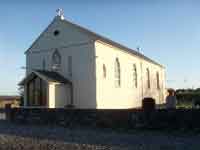 St. Colman is the Patron Saint of this area and his name is now recorded in the Churches, Cathedral and Schools of this Diocese. St. Colman travelled Ireland extensively in the 6th century spreading the faith and establishing Churches as he went.
St. Colman is the Patron Saint of this area and his name is now recorded in the Churches, Cathedral and Schools of this Diocese. St. Colman travelled Ireland extensively in the 6th century spreading the faith and establishing Churches as he went.
The Loughaderra area was a picturesque plot of farmland at that time and St. Colman was immediately struck by it as an ideal location for a church. He requested a site from the local chieftain but was refused immediately. That night there was a most violent storm, which flooded all of the Loughaderra area with the exception of the site of the present Church. The Chieftain, fearing that the rest of his land would also be submerged, sent for St. Colman and gave him the site which was not flooded and this has been the location for the Church ever since.
The area where the lake is now located was once covered by a dense, dark oak wood. It was part of the estate of an Elizabethan Seneschal of Imokilly who resided in, and ruled from the Castle of Castlemartyr nearby.
On one occasion after a Geraldine incursion the Seneschal, suspecting local co-operation with the invaders, collected a large number of residents in the immediate locality and, after a hasty and summary star chamber accusation pronounced all guilty. Not one of the accused persons was ever after seen alive or dead, and the grim details of a mass execution in the deep, dark oak-wood eventually became known. From that day the place was regarded as cursed, and within a year blight robbed the oaks of growth and leaf. Then during a winter night of howling, withering storm, devastation fell on Loughaderra, and when the daylight came no trace of tree or wood remained - only a wide expanse of gurgling, angry waters covering the place where they grew. Old inhabitants will tell you today that for long years after the naked treetops could still be seen on clear days far down in the lake's depths.
Click to Comment
RTÉ Radio 1- RTÉ 2fm
Lyric fm - Today fm
RTÉ Radió Na Gaeltachta
Cork's 96 fm -
Cork's 103 fm
Cork's Red fm - WLR fm
Weather
Area Map
Ballintotis OR Ballintotas?
Features of Loughaderra
Fishing
Record Catch
Origins of Loughaderra
The Peat Bog that Flooded
St. Colman's Site
The Wood that Vanished
Ermine Moths
South Western Regional Fisheries Board

Services

E-mail us











